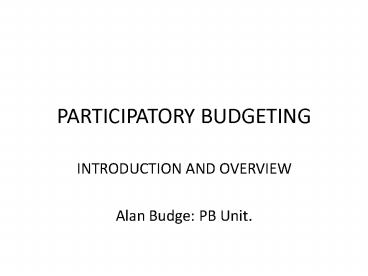PARTICIPATORY BUDGETING PowerPoint PPT Presentation
1 / 20
Title: PARTICIPATORY BUDGETING
1
PARTICIPATORY BUDGETING
- INTRODUCTION AND OVERVIEW
- Alan Budge PB Unit.
2
WHAT IS PARTICIPATORY BUDGETING?
- Participatory Budgeting (PB) engages people in
taking decisions on the spending priorities for a
defined public budget in their local area. This
means engaging residents and community groups to
discuss spending priorities, make spending
proposals, and vote on them, as well as giving
local people a role in the scrutiny and
monitoring of the process - DCLG draft
national PB strategy
3
OR
- Local people decide how to allocate part of a
public budget - Participatory
Budgeting Unit - Values Principles
and
Standards draft consultation - If it feels like we have decided ---- its PB.
- If it feels like someone else has decided,
it isnt. - Brazilian
resident involved in PB
4
HEALTH WARNING!
- Only a small percentage of any public budget will
be allocated using PB - The PB process is formally mandated and signed
off by the elected legislature
5
ORIGINS OF PARTICIPATORY BUDGETING
- Began in Porto Alegre, Brazil in 1980s city of
1.5m people - End of military dictatorship and election of
Workers Party - Started small 2/3 of investment budget but
built to up to 18 - Neighbourhood to region to city-wide assembly
6
DEVELOPMENT OF PB
- Spread to 140 cities in Brazil
- Now in 300 cities worldwide, including Latin
America, Canada, USA and 25 in Europe - Identified as good practise by international
institutions, including World Bank, UNESCO, OECD,
UN Habitat prize, and DFID - 30 authorities in UK now developing pilots
- Interest from 100 local authorities in all
- Strong support from government
7
Main features of classic PB model
- of mainstream budget devolved for PB allocation
- Citizens meetings/votes on priorities, services
and budgets - Neighbourhood and thematic structures which link
citywide - Annual cycle and investment plan
- Budget Matrix and Budget Council
8
The PB investment cycle
Local groups propose projects and decide
priorities
Investment into Communities
Technical analysis
Budget tables
Departmental budgets
Budget council report
Revenue Budget
Governing body
9
The Budget Matrix
10
Statistics eh?
11
Statistics eh?
12
Development of PB process
- In Porto Alegre, a 64 page Budget Matrix
booklet is produced annually, which enjoys
widespread circulation - The desire for this level of information
developed from the bottom up over a 25 year
period - You have to start somewhere
13
PB PILOT ACTIVITY IN THE UK - 1
- A grants pot /initiative funding- community
chest, NRF funds etc - Bidders for the money present proposals to
residents, who vote on which to support (eg
Sunderland, Bradford, Newcastle) - No annual cycle or link to mainstream
- But very effective at engaging/enthusing local
people
14
PB PILOT ACTIVITY IN THE UK -- 2
- Small scale mainstream allocation - where a
specific amount of devolved money e.g.for
environment, highways, community safety etc
issues - is allocated by local citizens in a
designated neighbourhood - Presentation by local authority or other agency
- Examples Salford and Birmingham
15
Potential Benefits of PB
- Engages more people and different people
- Better targeted and cost-effective services
- Consultation/engagement/involvement are
inevitable by products of a PB process - Strong social cohesion benefits
- Local ownership of projects/budgets/decisions
16
More potential benefits of PB
- More mature debate about priorities can reshape
relationship between elected members, officer,
and residents - Potential for higher tax-raising
- Develops budget literacy
- Greater transparency re public finances
17
In order to make informed choices re eg 5 of
budget to be allocated by PB, residents need to
know how the other 95 is spent
18
The participatory budget of Icapui, Brazil.
The left column reads, where the money comes
from. The one on the right reads, what the
money is spent for. Below it says, When the
administration is transparent, everything works
smoothly
19
PB - issues to consider
- How does PB fit with existing democratic
structures? - Is/should PB be representative?
- Is the expense justified?
- Will PB raise unrealistic/unmanageable
expectations?
20
- Participatory Budgeting ---- is a tool
which gives people a real and direct say about
how funds are allocated, and helps them to take
more ownership of their neighbourhood, to feel
able to say this is my street, my estate and Im
proud of it. - Hazel
Blears

